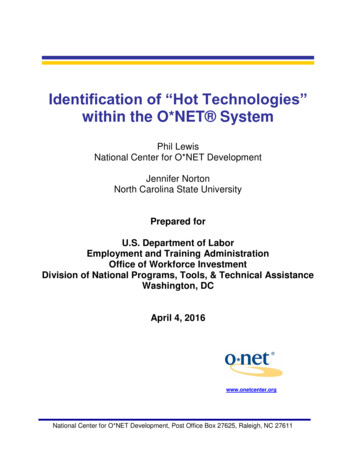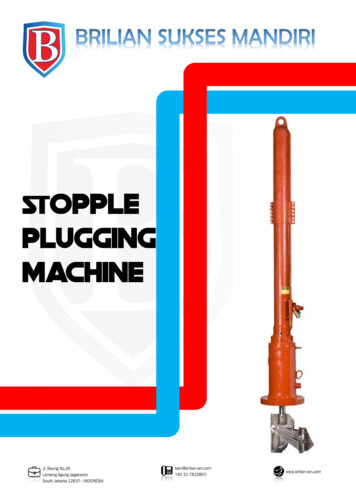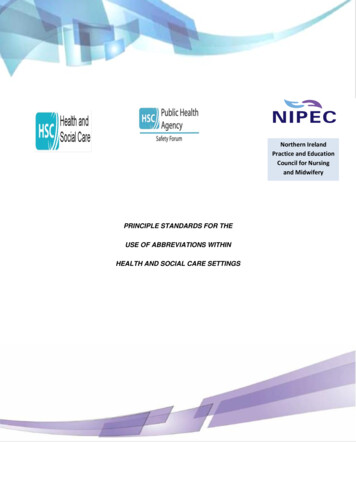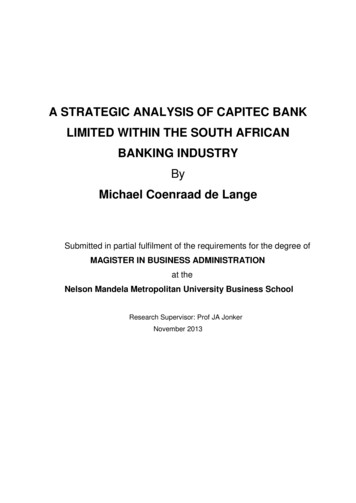
Transcription
Identification of “Hot Technologies”within the O*NET SystemPhil LewisNational Center for O*NET DevelopmentJennifer NortonNorth Carolina State UniversityPrepared forU.S. Department of LaborEmployment and Training AdministrationOffice of Workforce InvestmentDivision of National Programs, Tools, & Technical AssistanceWashington, DCApril 4, 2016www.onetcenter.orgNational Center for O*NET Development, Post Office Box 27625, Raleigh, NC 27611
Table of ContentsBackground. 2Hot Technologies Identification Procedure . 3Mine data to collect the top technology related terms . 3Convert the data-mined technology terms into O*NET technologies . 3Organize the hot technologies within the O*NET Tools & Technology Taxonomy . 4Link the hot technologies to O*NET-SOC occupations . 4Determine the display of occupations linked to a hot technology . 4Summary . 5Figure 1: O*NET Hot Technology Icon . 6Appendix A: Hot Technologies Identified During the Initial Implementation . 7National Center for O*NET Development1
BackgroundThis paper describes the initial identification of “Hot Technologies” within the O*NETSystem.A “Hot Technology” is a technologyrequirement frequently included in employerjob postings.The purpose of identifying hot technologies is to enable a wide variety of customers -students, job seekers, curriculum developers, employment and training providers,researchers, and policy makers -- to learn which software skills are in demand within thecurrent United States economy. Hot technologies will be reviewed and updated on aquarterly basis. Within the primary O*NET websites, a fire icon indicates technologiesthat are currently hot (see Figure 1). The primary O*NET websites include: O*NET Online (www.onetonline.org);My Next Move (www.mynextmove.org);My Next Move for Veterans (www.mynextmove.org/vets); andMi Proximo Paso (www.miproximopaso.org).In addition, in the near future, the hot technology information will be available via theO*NET Web Services (https://services.onetcenter.org/), allowing developers toincorporate hot technologies within their products and services.Tools and Technologies (T2s), the machines, equipment, tools, information technology,and software that are important to occupational performance, were initially includedwithin the O*NET System starting in 2006. Currently, more than 67,000 tools andtechnologies have been identified across the 974 occupations included within theO*NET-SOC Taxonomy (see: http://www.onetcenter.org/taxonomy.html). The T2database is available for download from the O*NET Resource Center(http://www.onetcenter.org/database.html?p 3#t2). The T2 information is also availablevia the O*NET Web Services.To learn about the original process for populating the T2 database, see O*NET Toolsand Technology: A Synopsis of Data Development Procedures and O*NET CenterTools and Technology Quality Control Processes. In addition to these methods,customers and professional associations are given the opportunity to help update andmaintain the T2 database by providing direct input on the T2 information for a particularoccupation via the “Tools & Technology Feedback Process” (see:http://www.onetcenter.org/t2 feedback.html). Finally, employer job postings are beingused as a new, rich source for identifying technology information.In order to make the collected T2 information more manageable and user friendly, eachNational Center for O*NET Development2
T2 example or “object” is organized into a taxonomic structure. Objects are classifiedaccording to the United Nations Standard Products and Services Code (UNSPSC).This system contains over 49,716 non-duplicative entries, and is organized into fourlevels of specificity (from most specific to least): Commodity, Class, Family, andSegment. For more details regarding the UNSPSC, see the organization’s website(www.unspsc.org). The classification facilitates a standard and common language forthe T2 information. Importantly, it allows for cross-occupational comparisons at a moregeneric level than the specific T2 object language might allow.Hot Technologies Identification ProcedureMine data to collect the top technology related termsThis initial step analyzes millions of employer job postings across all occupations. Themost frequently mentioned technology related terms (e.g., software and programminglanguages) are identified via data-mining software.To operationalize this step initially, Burning Glass Technologies (www.burningglass.com) was used to mine employer job postings from the calendar year 2015. Over26.5 million job postings were searched. The 200 software and programming skill termsthat were most frequently included in the job postings were identified.Convert the data-mined technology terms into O*NET technologiesThis step involves converting the mined terms into O*NET technology objects. TrainedO*NET occupational analysts conducted a rational review of the identified terms. Thereview included: Examining the level of specificity of the terms;Combining or collapsing similar terms;Comparing the terms to existing O*NET technology objects and commodities toidentify existing linkages;Updating the style and presentation format of those terms not linked to existingO*NET technology objects or commodities (e.g., adding the company name orspelling out identified acronyms).During the initial operationalization of this step, 156 unique hot technologies wereidentified. A total of 153 of the hot technologies are at the O*NET object level, whilethree hot technologies are at the broader commodity level. For a listing of hottechnologies identified during this first implementation, see Appendix A.National Center for O*NET Development3
Organize the hot technologies within the O*NET Tools & Technology TaxonomyThis step involves finding the appropriate commodity linkage for each of the hottechnology objects. For those identified as existing O*NET technology objects, thecommodity linkage already existed. For new technology objects, trained O*NEToccupational analysts reviewed the objects and made the commodity linkages. Therecommended linkages were also reviewed and confirmed by members of the O*NET ITteam.For the initial implementation of this step, the 153 O*NET object-level technologies werelinked to a total of 49 commodities within the O*NET Tools & Technology Taxonomy.Link the hot technologies to O*NET-SOC occupationsThe purpose of this step is to link the identified hot technologies to one or more of the974 O*NET-SOC occupations in the O*NET-SOC 2010 Taxonomy. For hottechnologies linked to existing O*NET technology objects, this step augments existingoccupational linkages. For hot technologies that are newly identified technologyobjects, this step serves as the initial population of occupational linkages.To begin the linking process, Burning Glass Technologies (www.burning-glass.com)was used to mine employer job postings from the calendar year 2015. The employerjob postings related to each of the 156 hot technologies were examined. Specifically,for each hot technology, a listing of occupations for which employers included theoriginal technology term within job postings was mined. Then, trained O*NEToccupational analysts conducted a rational review of the occupation list and retainedlinkages based on content and face validity.The outcome of this step led to the 156 hot technologies being linked to a total of 902O*NET-SOC occupations.Determine the display of occupations linked to a hot technologyThe goal of this step is to present the O*NET-SOC occupations linked to each hottechnology based on current employer demand. The occupations with the highestpercentage of job postings mentioning a particular technology term will be listed first.The occupations included in a lower percentage of the technology’s related job postingswill be ranked lower.Burning Glass Technologies (www.burning-glass.com) was used to mine employer jobpostings from the calendar year 2015. The employer job postings related to each of the156 hot technologies were examined. The order of the occupations, minus thoseremoved during the occupation linkage step described above, served as the initialpresentation rank. Occupational linkages previously identified for a particular hotNational Center for O*NET Development4
technology, but not appearing in the current review of employer job postings, wereplaced at the bottom of the occupational listing. If more than one of these legacyoccupational linkages existed, occupations were ordered within the list alphabetically bytitle.This step lead to a median of 26 occupations displayed per hot technology. Dependingon the particular hot technology, there is a wide range in the number of occupationspresented, ranging from 8 to 828.SummaryThis paper describes the O*NET Center’s initial identification of “Hot Technologies.”A “Hot Technology” is a technologyrequirement frequently included in employerjob postings.The concept of hot technologies was developed in order to enable a wide variety ofcustomers --students, job seekers, curriculum developers, employment and trainingproviders, researchers and policy makers -- to learn what types of software skills are indemand within the current United States economy. The hot technologies areincorporated within the primary O*NET websites. Hot technologies are distinguished bya fire icon. In the near future, the hot technology information will be available within theO*NET Web Services so that developers can easily incorporate this valuable additionwithin their products and services.The procedural steps for identifying hot technologies were described, including: Mining data to collect the top technology related terms;Converting the data-mined technology terms into O*NET technologies;Organizing the hot technologies within the O*NET Tools & TechnologyTaxonomy;Linking the hot technologies to O*NET-SOC occupations; andDetermining the display of occupations linked to a hot technology.Future plans include a quarterly review and update of the hot technology information. Inaddition, the efficacy of other data mining tools will be examined, such as the tool beingdeveloped by the University of Chicago’s Center for Data Science and Public Policy(DSaPP) for the Work Data Skills Cooperative (see: http://dsapp.org/sustainability/).National Center for O*NET Development5
Figure 1: O*NET Hot Technology IconNational Center for O*NET Development6
Appendix A: Hot Technologies Identified During the InitialImplementationAdobe Systems Adobe AcrobatAdobe Systems Adobe ActionScriptAdobe Systems Adobe AfterEffectsAdobe Systems Adobe DreamweaverAdobe Systems Adobe FireworksAdobe Systems Adobe FlashAdobe Systems Adobe IllustratorAdobe Systems Adobe InDesignAdobe Systems Adobe Photoshop softwareAdvanced business application programming ABAPAJAXApache CassandraApache HadoopApache HTTP ServerApache MavenApache PigApache SolrApache StrutsApache TomcatApple Final Cut ProAutodesk AutoCADAutodesk AutoCAD Civil 3DAutodesk RevitBentley MicrostationBlackbaud The Raiser's EdgeBlackboard softwareCC#C CA Erwin Data ModelerCitrix softwareCommon business oriented language COBOLComputer aided design CAD softwareComputer aided manufacturing CAM softwareCustomer information control system CICSDassault Systemes CATIA softwareData entry softwareDelphi softwareDrupalDynamic hypertext markup language DHTMLEclipse softwareEnterprise JavaBeansNational Center for O*NET Development7
Enterprise resource planning ERP softwareEpic Systems softwareESRI ArcGIS softwareEXT jsExtensible HyperText Markup Language XHTMLExtensible markup language XMLFileMaker Pro softwareFund accounting softwareGeographic information system GIS softwareGoogle AdWordsGoogle AnalyticsHandheld computer device softwareHealthcare common procedure coding system HCPCS softwareHewlett Packard HP-UXHewlett Packard LoadRunnerHibernate ORMHuman resource management software HRMSHypertext markup language HTMLIBM Cognos ImpromptuIBM DominoIBM InfoSphere DataStageIBM NotesIBM Power Systems softwareIBM WebSphereIntegrated development environment IDE softwareIntuit QuickBooksJavaScriptJob control language JCLjQueryKornShellLAMP StackLexisNexis softwareLinuxMcAfee softwareMedical condition coding softwareMedical procedure coding softwareMEDITECH softwareMicrosoft .NET FrameworkMicrosoft AccessMicrosoft ActiveXMicrosoft Dynamics GPMicrosoft Dynamics softwareMicrosoft ExcelMicrosoft Exchange ServerMicrosoft OutlookMicrosoft PowerPointNational Center for O*NET Development8
Microsoft ProjectMicrosoft PublisherMicrosoft SharePoint softwareMicrosoft SQL Server Reporting ServicesMicrosoft SQL Server softwareMicrosoft VisioMicrosoft Visual BasicMicrosoft Visual Basic Scripting Edition VBScriptMicrosoft Visual StudioMicroStrategy softwareMinitab softwareMongoDBMySQL softwareNagiosNational Instruments LabVIEWNode.jsNoSQL softwareObjective COracle Business Intelligence Enterprise EditionOracle E-Business Suite FinancialsOracle Eloqua softwareOracle Hyperion softwareOracle JavaOracle JavaServer Pages JSPOracle JD Edwards EnterpriseOneOracle JDBCOracle PeopleSoft FinancialsOracle PeopleSoft softwareOracle PL/SQLOracle Primavera Enterprise Project Portfolio Management softwareOracle SolarisOracle WebLogic ServerPerforce Helix softwarePHP: Hypertext PreprocessorPostgreSQL softwarePractical extraction and reporting language PerlPTC Creo ParametricPuppetPythonQlik Tech QlikViewRRed Hat Enterprise LinuxRed Hat WildFlyRelational database management softwareRuby on RailsSage 50 AccountingNational Center for O*NET Development9
SAP Business Objects softwareSAP Crystal ReportsSAP softwareSAS softwareSplunk EnterpriseSpring FrameworkSPSS softwareStataCorp StataStructured query language SQLSybase softwareSymantec security softwareTableau softwareTax softwareTeradata DatabaseThe MathWorks MATLABTransact-SQLUnified modeling language UMLUNIXVerilogVERITAS NetBackupVirtual private networking VPN softwareWiresharkNational Center for O*NET Development10
Eclipse software Enterprise JavaBeans . National Center for O*NET Development 8 Enterprise resource planning ERP software Epic Systems software ESRI ArcGIS software EXT js Extensible HyperText Markup Language XHTML Extensible markup language XML FileMaker Pro software Fund accounting software Geographic in











